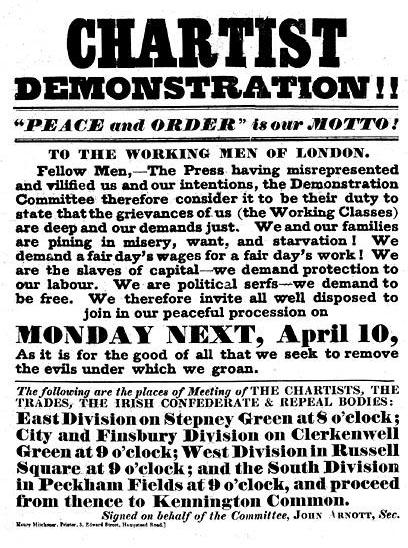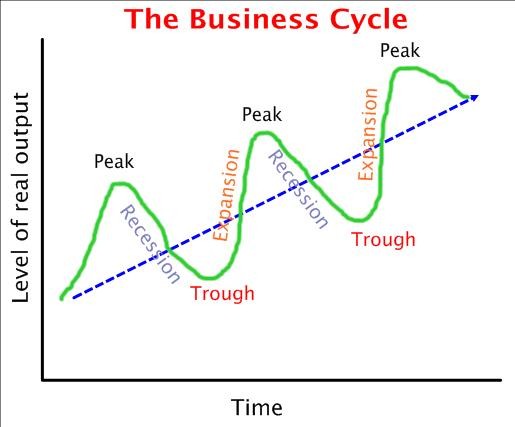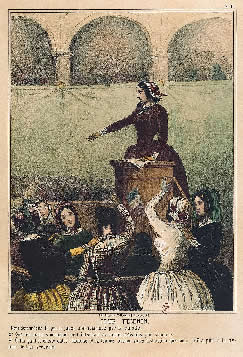UNIT 3: EVOLUTION OF LIBERALISM
| Site: | MoodleHUB.ca 🍁 |
| Course: | Social 30-1 RVS |
| Book: | UNIT 3: EVOLUTION OF LIBERALISM |
| Printed by: | Guest user |
| Date: | Thursday, 6 November 2025, 5:44 PM |
Table of contents
- 1. OVERVIEW
- 2. Concepts and Terms
- 3. Dealing with Classical Liberalism
- 4. Problems
- 5. Quiz 3.1
- 6. Response: Classical Conservatism
- 7. Response: Marxism
- 8. Response: The Luddites
- 9. Response: Chartism
- 10. Response: Utopian Socialism
- 11. Response: Democratic Socialism
- 12. Response: Welfare Capitalism
- 13. Response: Progressivism
- 14. Quiz 3.2: Critical Viewing
- 15. Capitalism as Economic Liberalism
- 16. Laissez-Faire Capitalism
- 17. Role of Government: Changes
- 18. Economic Liberalism
- 19. The Great Depression
- 20. The Great Depression in Canada
- 21. Keynesian Economics
- 22. Quiz 3.3: Economic Systems
- 23. Modern Liberalism
- 24. Labour Movement
- 25. Universal Suffrage
- 26. Women's Rights
- 27. Welfare State
- 28. Human Rights
- 29. Unit three Summary
1. OVERVIEW
Overview: How did Liberalism Evolve?

Significant changes that take place in society do not happen quickly. Also, they do not happen without some unrest. The same was true with liberalism.
Although classical liberalism brought with it many positive changes, it also presented many challenges to society.
- Can you think of any reasons people might disagree with classical liberalism?
- Is classical liberalism missing any key values you believe in?
Ideologies are ideas about what kind of political and economic systems will produce an ideal world. The principles of classical liberalism led to democracy and capitalism-the dominant political and economic systems in the Western world today. But did the ideals proposed by the great thinkers, leaders, and citizens work?
As you will learn in this unit, citizens, economists, and philosophers found much to criticize in classical liberalism. Some responded by constructing new ideologies that they believed would serve people better. Others fought for changes to liberalism that would lead to a more just and equal society.
- To what extent is resistance to liberalism justified?
As you read the pages that follow, look closely at the images provided, and complete the required textbook readings, take notes about the evolution of liberalism. In this unit, you will continue to develop your skills in interpreting various sources of historical information.
This unit has three sections:
- How did societies and ideologies respond to classical liberalism?
- How did capitalist economic systems respond to classical liberalism?
- How did modern liberalism evolve?
2. Concepts and Terms
Unit Three Concepts and Terms
Unit Question: How did liberalism evolve?
Issue Question: To what extent is resistance to liberalism justified?
In this unit, you will explore the following big ideas based on questions arising from the issue question:
- Changes to societies occurred because of the effects of classical liberalism, including the development of new ideologies.
- Economic systems responded to classical liberalism through adaptations to capitalism, including the development of the welfare state and the development of socialism and communism.
- Liberalism has evolved to include support for equal rights in a representative democracy. This was a direct response to the opportunities and challenges presented by classical liberalism. With this belief came a greater role for government in society.
This is a list of new terms you will encounter in this unit.
business cycle
demand-side economics
democratic socialism
economics
capital
Chartism
classical conservatism
deficit
depression
evolution
fiscal policy
human rights
inflation
labour standards
labour unions
Luddites
Marxism
means of production
modern liberalism
monetary policy
New Deal
proletariat
recession
regulation
socialism
supply-side economics
universal suffrage
Utopian socialism
welfare capitalism
welfare state
3. Dealing with Classical Liberalism
Dealing with Classical Liberalism

Look closely at the 1911 poster entitled "The Pyramid of the Capitalist System" for a perspective on classical economic liberalism. This poster was produced by the Industrial Workers of the World, an international labour union that emerged in the United States.
- At the top of the pyramid labelled "capitalism" is a bag of money. It is supported by a king and two well-dressed male politicians with the label "WE RULE YOU."
-
The next level of the pyramid contains three male church leaders with the slogan "WE FOOL YOU."
-
Supporting the church and political leadership is the military, labelled "WE SHOOT AT YOU."
-
Under the military is a dining table surrounded by well-dressed men and women of the upper class, with the phrase "WE EAT
FOR YOU."
- At the base, holding up the entire pyramid are the men, women, and children of the working class with the label "WE WORK FOR ALL-WE FEED ALL."
Review how classical liberalism emerged in Britain. It is important to understand how individualism was promoted - both politically and economically during the 19th Century. The main question that emerged was, to what extent should government be involved in the lives of its citizens? This unit explores the evolving answer to this question.
Although classical liberalism promised an ideal world based on individual rights and freedoms, it fell short in many respects. Although the economic freedom, self-interest, and competition of a capitalist economic system made many people rich, it led to the exploitation of the working poor. Only the wealthy aristocracy who inherited land had the right to vote.
A new class system based on wealth threatened to replace the previous class system that was based on inherited position and affiliations with the church. Inequality and limited rights for workers were significant problems. Despite calls for equality, women were not treated as equal to men in any respect. They had few legal rights and could not vote to change the rules. Child labour was commonplace.
In this unit, you will investigate the evolution of liberalism through a study of historical images and documents. Classical liberals argued for greater rights and freedoms for individuals, and based on a society with no representative government and an absolute monarch, granting rights to more men was considered great progress in many societies.
But what classical liberals claimed was individual rights and freedoms falls short of how modern liberal societies interpret equal rights today. The ideology still considered some groups of men and women (and immigrants) along a hierarchy, and as a result, is considered elitist (right wing) on the ideological spectrum.
Not everyone agreed that classical liberalism was the best ideology, and as a result, new ideas emerged in response to fix the problems brought on by too much individualism.
- How did society respond to the consequences of classical liberalism?
4. Problems
Problems with Classical Liberalism

Did everyone benefit from classical liberalism? While the implementation of classical liberal principles brought with it the promise of prosperity and freedom for everyone, the reality was much different.

As well, First Nations in the Americas and other colonized people around the world had few rights.
Although the Industrial Revolution changed the economies of the world dramatically, and classical liberalism led to greater rights for the middle and upper classes, its long-term effects on the working class are historically the subject of great debate. One group argues that the standard of living of the average worker improved during industrialization; another believes that the standard of living fell during this period. Whatever the short-term effect, industrialization leads eventually to an improved standard of living
for workers. However, in the short-term, there was a great deal of suffering for workers and their families; the working class did not experience a high (or improved) quality of life under classical liberalism.
The Effectiveness of Classical Liberalism
Classical liberalism was based on ideals, including the idea of the "self-made man". According to liberal thought, when people are free to make their own choices about how hard to work and what to produce, they will prosper. The reality was much different. No matter how hard thousands of poor labourers worked, they could not get ahead. They were also unable to vote for fairer laws to protect all human rights equally. Classical liberalism also held a view that the government's role was small and should remain limited. It was to ensure only equal treatment under the law and to protect people and their property. As the gap between rich and poor widened, people began to challenge the effectiveness of classical liberal ideas in society.People responded to these social injustices in two ways:
- Reforming liberalism so that it met the needs of society
- Rejecting liberalism and proposing new ideas that would work better for more people

Those who proposed a new form of liberalism believed that the poverty, squalor, and ignorance in which many people lived made it impossible for freedom and individuality to flourish. This led to a more inclusive and equal society, based on modern liberalism.
Others, notably Karl Marx and Friedrich Engels, felt that capitalism itself was at fault and that the average person would never have his or her needs met as long as the wealthy class was allowed to profit from the labour of the working class.
"Absolute Kings Forced to Swallow Pill of Constitution" is the caption on this cartoon published in France in 1848. The cartoonists uses several techniques to poke fun at the rulers of Europe of the time.
Look closely at the image. Look for details and techniques that show the perspective of the cartoonist and the message behind the image.
Political cartoons use humour to convey serious political or economic ideas. What ideas about classical liberalism are conveyed in this cartoon?
5. Quiz 3.1
Please visit the 3.1 quiz link found in the unit tab and complete it.
6. Response: Classical Conservatism
Classical Conservatism

National Portrait Gallery, London
When people are confronted with change, they often think that things would be better if society could just go back to another era. The same was true with classical liberalism. People or movements that reject change in favour of returning to a previous way of doing things are considered reactionary. As discussed in Unit One, classical conservatives sit on the right side of the political spectrum.
The Luddites were one group of reactionaries. While they committed violence, another group of people reacting negatively to this new change were classical conservatives. They did not want to commit violence. But classical conservatives, whose most famous thinker was Edmund Burke, believed in the positive legacy of the past.
They believed that the institutions of their time, such as political systems, the military, and the Church, were products of years of thought and labour. These traditions were considered vital aspects of society, and should not be discarded in favour of new ideas. They also believed that people do not all have equal abilities and, therefore, a nation's leaders should be chosen by an elite group who have special rights and privileges.
- How were these ideas a rejection of classical liberalism?
- Do you think these ideas are justified? Support your position.
Do you think this cartoon says something about Classical Conservatism?
- What is the context of the source?
- Do you think it is funny?
Identify the perspective
Consider the context of the image, which will provide you with clues to help you interpret the source. What are the circumstances surrounding the event or situation in the source? You need to draw on your knowledge of history and ideologies to understand
the source. Use details from the source to help you understand the following: 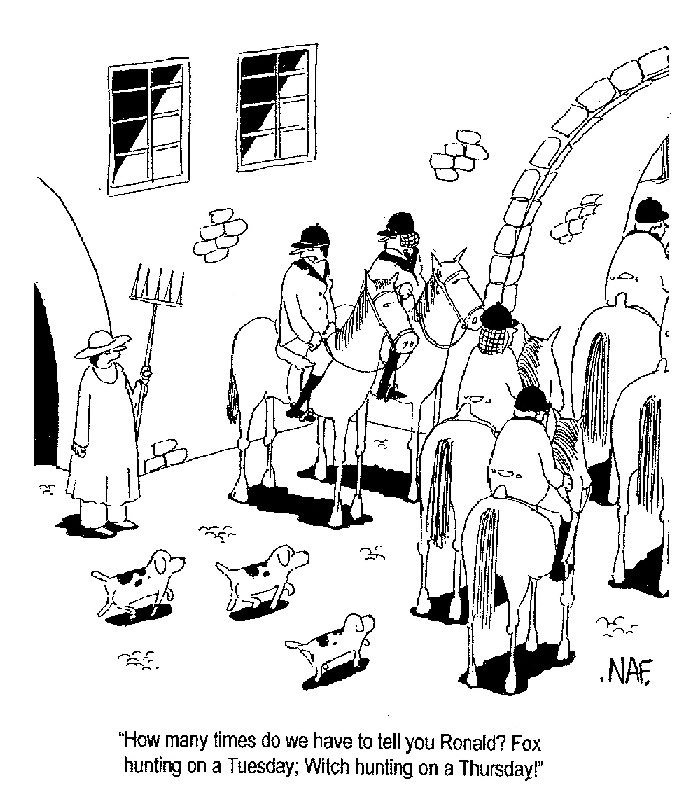
|
Inference |
Evidence |
|
Where? The courtyard of an old building |
|
|
When? Event occurred in the past, but cartoon was made in the modern day |
|
|
Who? Rich people |
|
|
What? People are going fox hunting |
|
|
Ideological Perspective: Modern Liberalism |
|
|
Links to Liberalism: Individual Rights and Freedoms-and end to the class structure |
|
7. Response: Marxism
Rejection of Classical Liberal Society
One of the biggest problems associated with the economic effects of classical liberalism was inequality of the working class and the wealthy people who owned the means of production. While the Chartists lobbied for better laws to protect workers,
and the Utopian Socialists tried to effect change in their own factories, others suggested that an entirely new ideology was needed to resolve the injustices brought about throughout history. Socialism is a collectivist ideology that supports economic equality and cooperation. It advocates a fair distribution of resources through public management. In other words, socialists believe that the "means of production" (land, labour, and capital) should not be owned by individual people for personal profit, but they should be controlled by the public for the benefit of everyone.
The term "scientific socialism" came from Karl Marx and Friederich Engels who believed that the great social injustices and inequalities brought about by the Industrial Revolution could never be resolved through a capitalist democracy. They believed that as long as one class of people owned the land, factories, and mines, they would always exploit those who worked for a living.
Marx believed, through his study of history, that the upper class always exploited the working class and a revolution in which the working class rose up and took charge would be the natural result of years of injustice. He did not believe that society could create a more just society peacefully.
Marx and Engels were not political or economic leaders. They were two educated men who had ideas about how the world worked, and how it should work. The promise of an ideal society presented by these ideas captured the imagination of people around the world. These theories morphed into practice in many parts of the world, resulting in the distinct ideologies of socialism and communism that you will learn more about.
Beliefs of Karl Marx
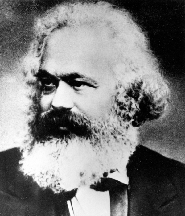
He felt that the long-term consequence of unregulated capitalism would be the enrichment and empowerment of the bourgeoisie (capitalist class) and the continued impoverishment of the proletariat, or working class.
Marx believed that a massive, well-organized, and violent revolution would be required in some nations because the ruling class would not give up power without a fight. He believed the revolution would be violent in Germany, but it could be achieved in Great Britain and the United States through parliamentary change. He felt that a system controlled by the working man would result in a fair distribution of power and wealth.
Marx's Main Ideas
- Throughout history, the various classes of human society have been in ongoing conflict with one another.
- Those who labour sell themselves as a commodity, no more than slaves of the wealthy.
- Eventually, the proletariat will emerge victorious over the wealthy bourgeoisie.
- The state that results from the workers revolution will include a strong centralized government and an economic system in which all industry, communication, and transportation are controlled by the government. There is no private property or inheritance, all citizens are expected to work, there is a progressive system of taxation on incomes, and education is free.
- What are the main ideas of Marxism?
- How were these ideas a rejection of classical liberalism?
- To what extent is Marxist resistance to liberalism justified?
Karl Marx and His Relevance Today
How relevant is Marxism today? Consider the following:- Karl Marx was voted the "Greatest Thinker of the Millennium" by voters on the British Broadcasting Corporation.
- Rolling Stone Magazine wrote "Marx was Right: 5 Surprising Ways Karl Marx Predicted 2014."
- Right wing Fox News editorial in 2018 "Is Teen Vogue turning Karl Marx into its next teen idol?"
8. Response: The Luddites
The Luddites
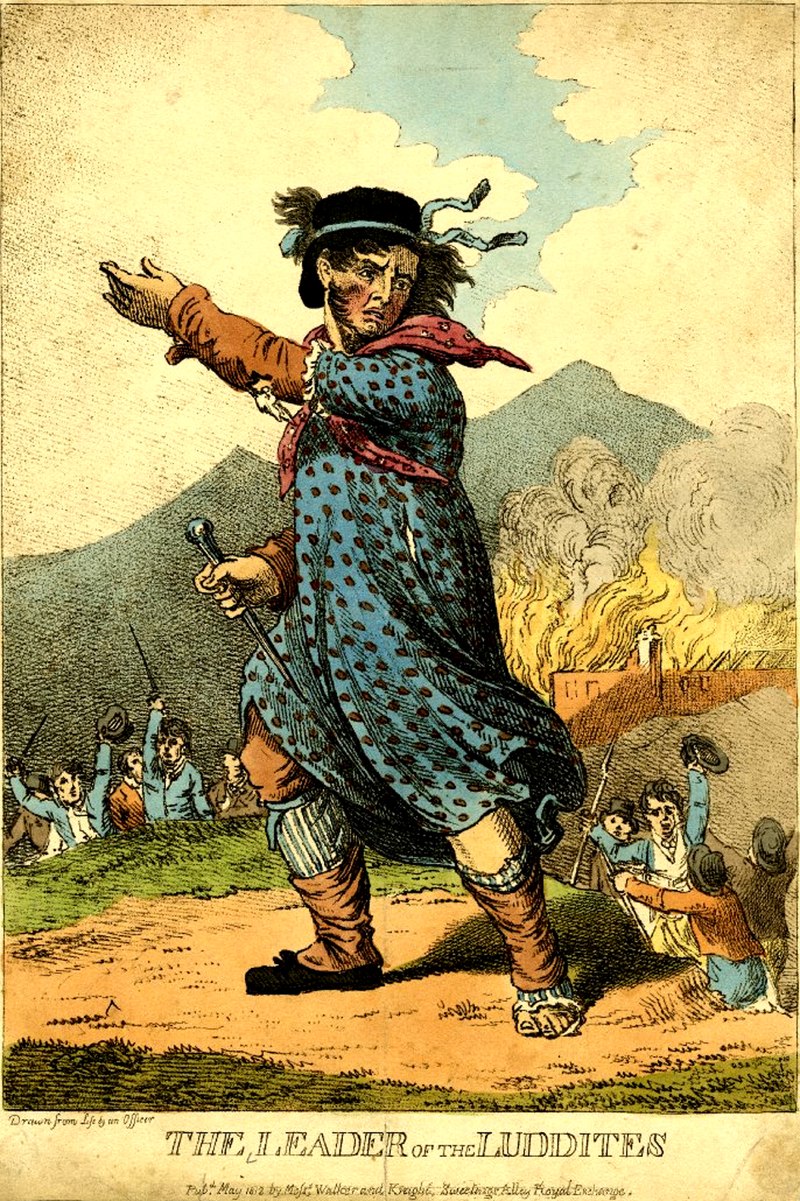
The Leader of the Luddites
Courtesy of Wikipedia
When a new movement or idea occurs, often one of the first reactions is simply to reject the idea immediately. Perhaps your parents or grandparents or even someone the same age as you finds the newest gadget impossible to use. Sometimes these people are referred to as "Luddites", which dates back to 1811.
When the Industrial Revolution began, many people were put out of work. The first people to be affected were the textile workers. Before the Industrial Revolution, many people in England manufactured wool and cotton cloth in their own homes under the domestic system.
After the production of textiles became mechanized, these skilled workers replaced these relatively unskilled workers who made fabric in the factories. By 1811 these skilled labourers became violent in their protest of this change.
Allegedly lead by "Ned Ludd", the Luddites formed their own little army called "the Army of Redressers" who spent the next six years destroying textile machinery. As a response, the British Parliament passed the Frame-Breaking Act in 1812, which increased penalties for Luddites and others who destroyed private property.
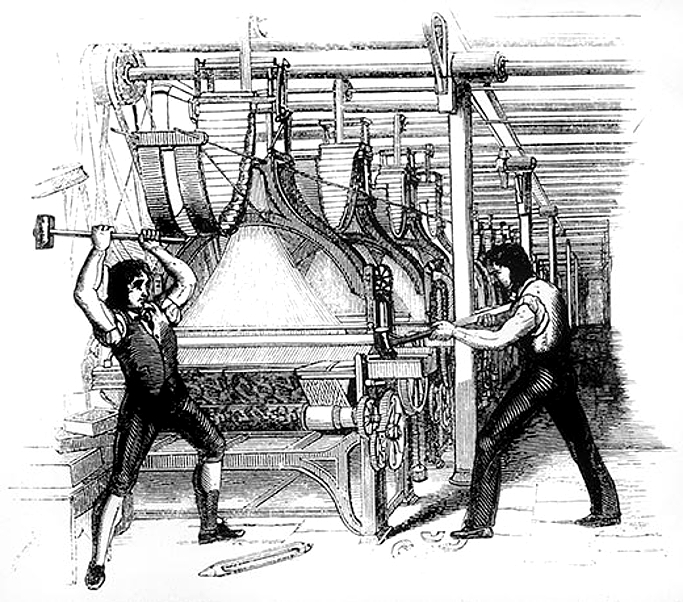
9. Response: Chartism
Chartism
Reforming Liberalism through Political Action
As a result, one response to classical liberalism was the emergence of Chartism, which as a working class movement that emerged in Great Britain during the 1830s. Chartists believed that the individual rights promised by classical liberalism did not benefit enough people.
Chartists sought greater political rights in Britain from 1838-1857. This largely working class group believed that the British parliament, largely controlled by the middle class, had failed to deal with the negative economic and social impacts of the Industrial Revolution.
Their name was derived from a charter, or formal document called The People's Charter, which was published in 1838, and publicized the group's 6 main demands of British Parliament:
- universal suffrage (voting) for all men over age 21
- equal-sized electoral districts (equal representation)
- vote by secret ballot (to avoid peer pressure)
- pay for elected members of parliament (to eliminate wealth as a pre-requisite to serve in government)
- yearly elections (periodic accountability for politicians)
- members of parliament not required to own land (would enfranchise all working class men in urban centres)
Although middle and upper class men in Britain could vote, members of the working class could not. They could not push for political changes that would benefit themselves and their families. in 1839, the Chartists and their supporters presented Parliament with 1.3 million signatures requesting their demands (listed above) be debated in the House of Commons.
Anger mounted as politicians chose to ignore these concerns. Chartist leaders threatened a general strike (collective action) by all workers. Some became radicalized and planned riots. In 1839, in South Wales, a confrontation between marchers and troops led to violence. More than two dozen were killed and another 50 wounded in the battle. Other similar actions across England led to uprisings that were snuffed out by armed soldiers. Many served long prison sentences doing hard labour.
In 1842, Chartists once again attempted to submit 3 million signatures on a petition that once again, was rejected by Parliament. Strikes broke out across England and Scotland as many workers demanded the charter be put into law. The government responded by imprisoning most Chartist leaders. Despite this hard line, chartists continued to protest the lack of political rights.
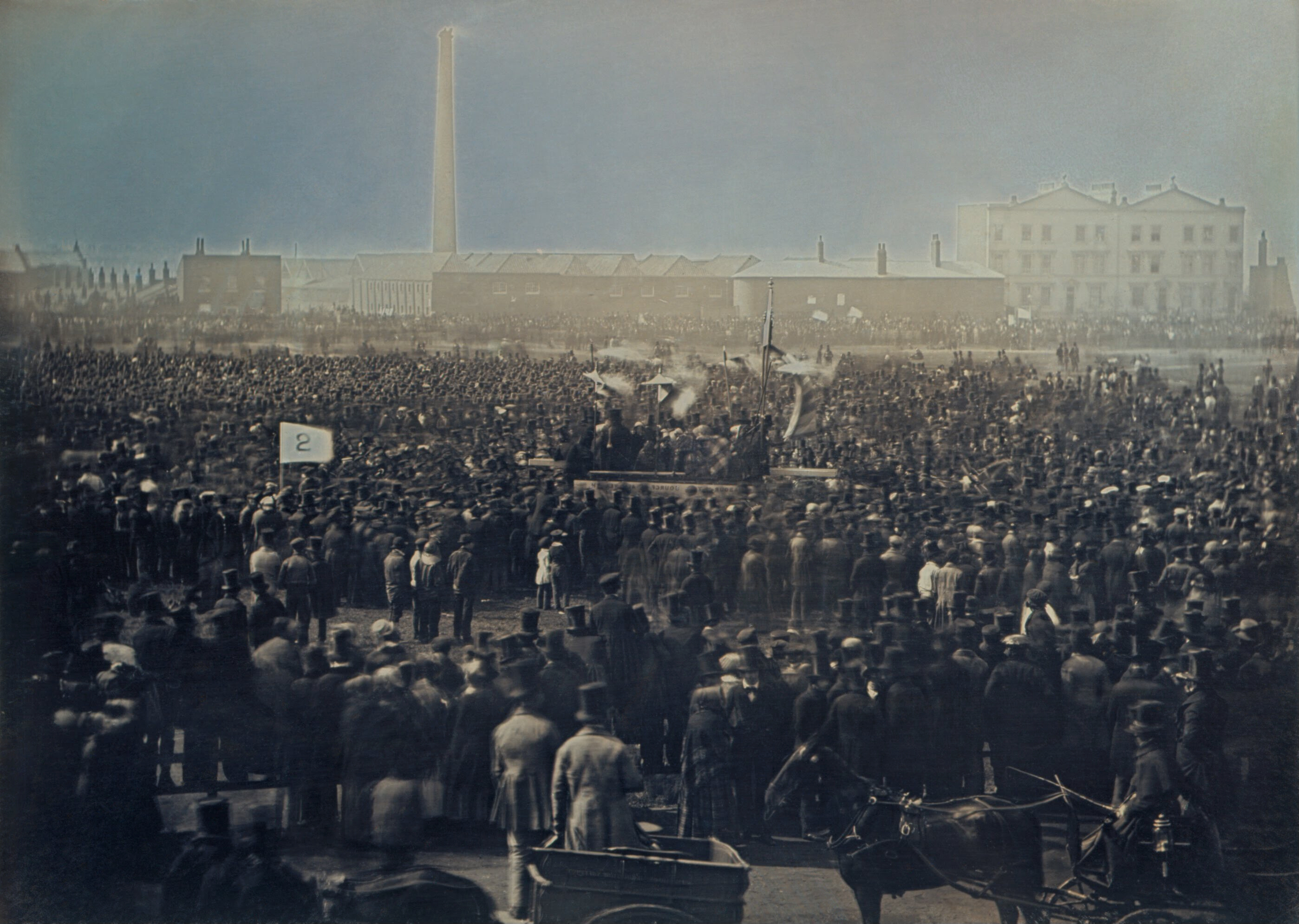
Bolstered by political revolutions sweeping Europe, Chartists attempted a third petition to parliament in 1848. Leaders organized a mass rally at Kennington Common in London to demonstrate the collective support for these political reforms. Once again, the demands were not accepted or debated by the House of Commons and Chartism faded from the public spotlight.
However, the call for universal suffrage and greater political freedom continued for decades, just in a less organized fashion. In 1867, the Reform Act officially expanded the franchise (vote) to urban working men. In 1872, secret ballot was passed and in 1911 politicians became paid employees with the Parliament Act.
As you read, consider the question:
- To what extent was Chartist resistance to classical liberalism justified?
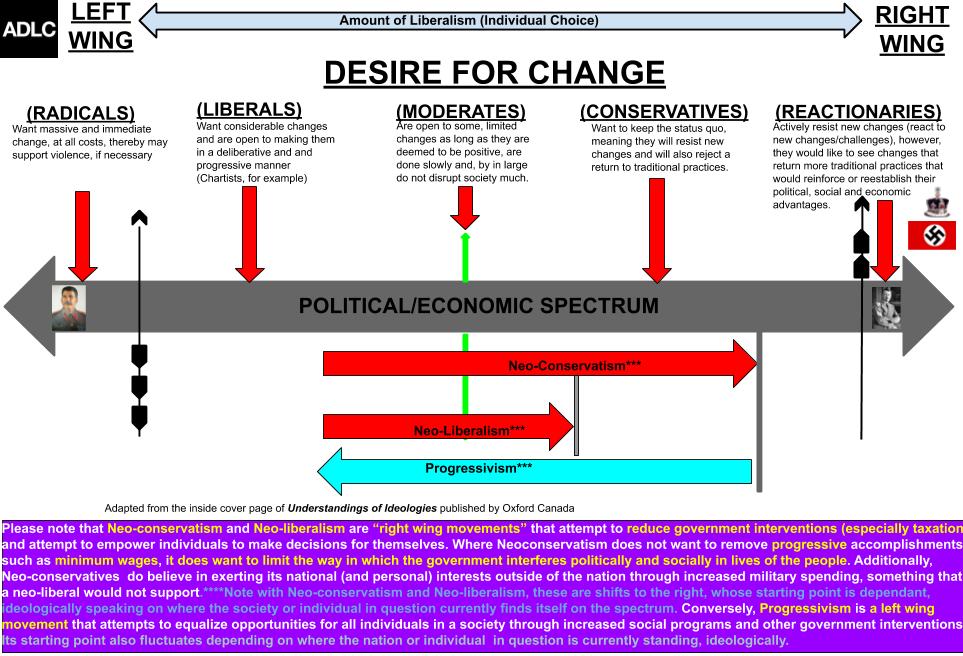
- What ideas are presented in response to classical liberalism?
- How did these movements reject classical liberalism?
10. Response: Utopian Socialism
Utopian Socialism

Modern day democratic Socialism traces its roots back to utopian socialism of the 19th Century.
Two of the most famous 19th Century utopian socialists were Charles Fourier and Robert Owen.
In the late 18th Century, the French thinker Francois Marie Charles Fourier believed that cooperation was key to a society's productivity, and that individuals should be rewarded for their contributions to the collective whole.
He also promoted childhood education, and believed that human reason, along with collaboration, would create social unity. His ideas were influential in France's 1848 Revolution, where the right to work became a major issue.
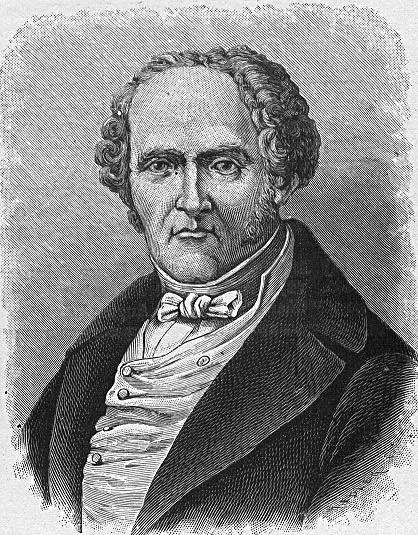
Charles Fourier
1772-1837
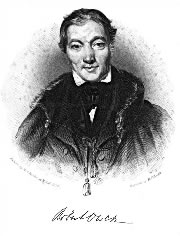
Robert Owen
1771-1858
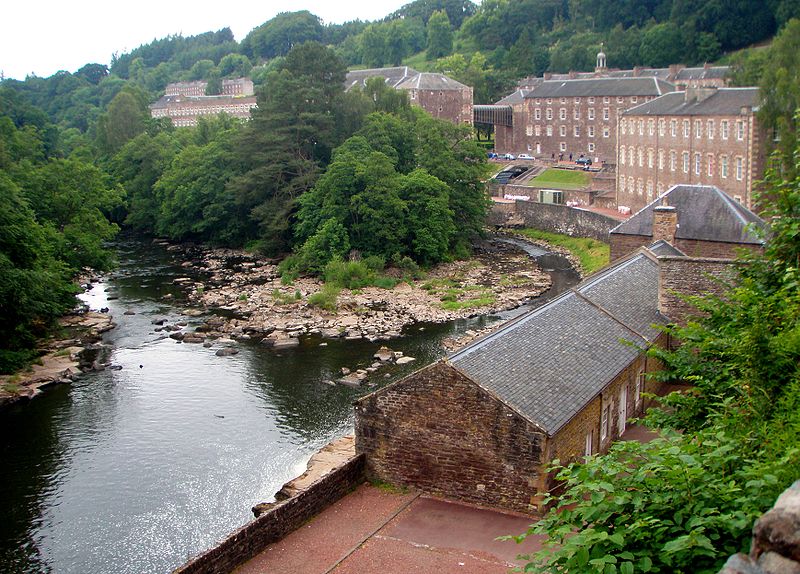
Creative Commons Wikipedia
From his own experience as a child labourer, Owen felt that children who grew up in the squalid conditions of the factory and mining towns of Great Britain would never rise above their working class without proper education.
Utopia refers to 'paradise' and Owen promoted the idea that the perfect living and working conditions could be created in a community that took care of its citizens. One's potential could be reached through education, and this was achieved when society ensured the economic and social well being of its citizens.
In 1800 Owen became the manager of a mill in New Lanark, Scotland. Soon after, he and several partners bought the mill and Owen began incorporating his utopian socialist ideals into a model community.
Besides reducing work hours and limiting child labour, he created an education centre and provided infant care for working parents. Cooperation was emphasized and worker incentives were introduced to reward productive employees. Owen spent the rest of his life writing and speaking about utopian socialist principles with the hope of bringing about factory reform in Britain.
In 2001, New Lanark became a UNESCO World Heritage site.
As you read about Utopian Socialism, take notes on the following:
- What are the main ideas in utopian socialism?
- Which classical liberal principles were rejected?
- How do they attempt to extend greater freedoms for all?
- To what extent was utopian socialism successful?
11. Response: Democratic Socialism
Democratic Socialism

This type of socialism believes in democracy, or representative government, and places itself to the left of liberalism on the ideological spectrum. Socialists desire greater economic equality, including rights for the working person, laws to protect workers, health services, education, and controls over the economy.
What's the difference between Marxism and Socialism?
Marxism
- Believes revolution is needed to overthrow liberal society.
- Abolish private property.
- Total government control of the economy.
Socialism
- Gradual and peaceful change can occur under elected governments.
- Private property is still allowed, but some property is placed in public (government by the people) hands.
- Some control over economy including regulations and ownership of key industries (for example, the postal system)
- Is democratic socialism a complete rejection of classical liberalism, or an extension of greater freedoms for all?
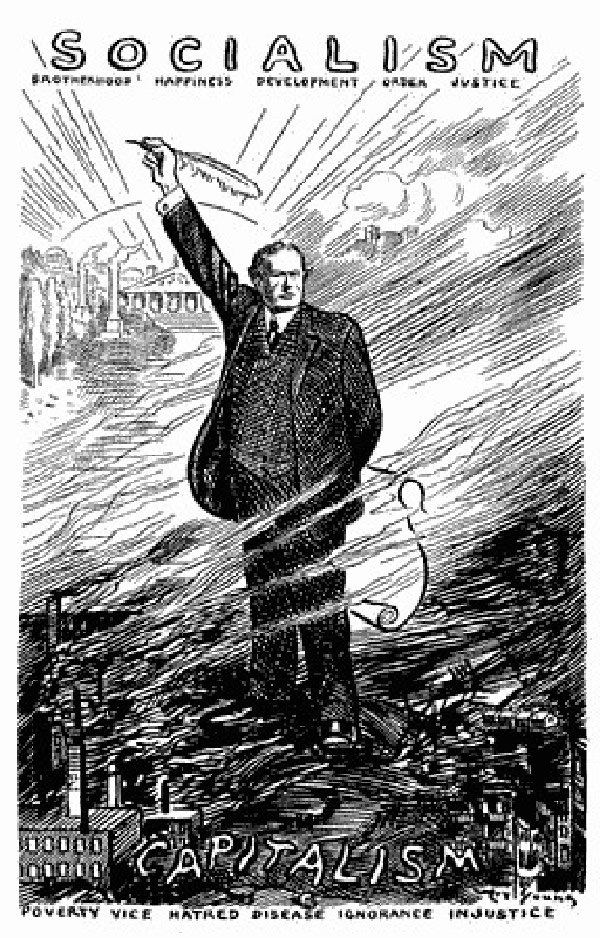
- What dominates this image?
- Who do you see in the image?
- Where did this occur?
- When did it occur?
- Why was this image created?
- What is the main idea in the source?
- What ideological perspective is shown?
- How is the source connected to liberalism?
- Does the source primarily support or reject the principles of liberalism?
- Does this image represent socialism as Marx described it, or does it reflect democratic socialism in a liberal democracy?
- Why is the man holding a quill pen and a piece of parchment?
- What does the building in the background in the upper left represent?
12. Response: Welfare Capitalism
Welfare Capitalism
Marxism, communism, socialism, and classical conservatism were ideologies based on the belief that classical liberalism did not work and new ideologies should be adopted. However, many believed that classical liberalism could be changed to meet the needs
of the majority and, thus, lead to the "common good".
Welfare Capitalism
Welfare Capitalism was encapsulates the efforts made by industrialists during the late 19th Century and early 20th Century to ensure better working conditions for their employees. This was done partly out of self-interest; by taking better care of their workers, business owners were hoping to avoid labour unrest and collective action such as unions. Others had more humanitarian goals in mind, and believed that employees had legitimate complaints about their working conditions.As a result, American industrialists and business owners began to offer workers certain benefits and rewards. In other parts of the industrialized west, welfare capitalism began to be recognized as classical liberal economy regulated with some government legislation that provided greater protections for workers.
The path to greater worker protections was a long one in most European nations. It took most of the 19th Century, with a series of laws called the Factory Acts. This included legislation to reduce the number of hours worked per day, regulated child labour and other factory conditions.
While some progress was made in limiting capitalist self-interest in the pursuit of profit at the expense of workers, many industrialists refused to enact any such reforms. As a result, President Theodore Roosevelt (1901-1909) took up the fight for better treatment of workers at the hands of their employer. His efforts to place restrictions on worker exploitation are also covered under the movement known as progressivism.
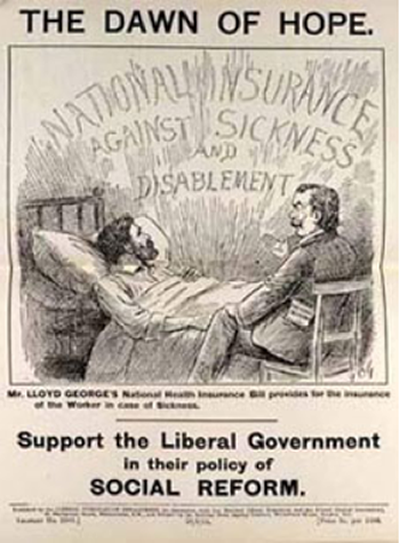
Historical Context
Remember that, under classical liberalism, the principles of economic freedom and self-interest meant that many benefits we take for granted today were not offered by the government or the workplace. If you got sick, you paid for your own medicine, doctor, and hospitalization (self-reliance). If you did not have the money for it, you did not get the service needed. If you were injured on the job, you were out of work without pay. Your employer would not help you, and there was no workers' compensation as there is today.Consider the poster "The Dawn of Hope". Note that it is a campaign poster for the Liberal Party of Britain and it advocates "social reform". The caption states, "Mr Lloyd George's National Health Insurance Bill provides for the insurance of the worker in case of sickness."
Look closely at the details in the picture. The words in the background are displayed like a sunrise and the sick man on the bed stares up at them. These details and the heading, "The Dawn of Hope", convey the idea that under an elected Liberal government the state-run health insurance plan will bring hope for everyone.
By the beginning of the 20th Century, modifications to liberalism took various forms in the United States and Europe.
In the U.S., some industrialists began to help their workers by providing them with other benefits such as free housing or health care. One example is Henry Ford's efforts to retain workers on his assembly line. Although this worked for awhile, eventually the government began to step in to protect workers.
In Britain and the remainder of Europe, political parties began to take a different approach by enacting laws to protect workers. Although these laws took many years to pass, they implemented protection for workers and resulted in policies and programs to support the middle and working classes.
- How did welfare capitalism signify a shift to the middle of the ideological spectrum? In other words, an extension of greater rights for all?
- Explain the role of government under welfare capitalism.
- List any case studies or examples of welfare capitalism.
13. Response: Progressivism
Progressivism
Remember, that broadly defined, liberalism is the belief in the dignity and freedom of the individual as the foundation for society. Liberalism has faith in human progress, and believes that respect for all individuals is paramount. Progressivism signifies the belief in positive reform for greater equality. How to best achieve that common good has changed over time, as classical liberals believed this was achieved by freedom from government, and modern liberals believe that government can create the opportunities for true political and economic freedom.
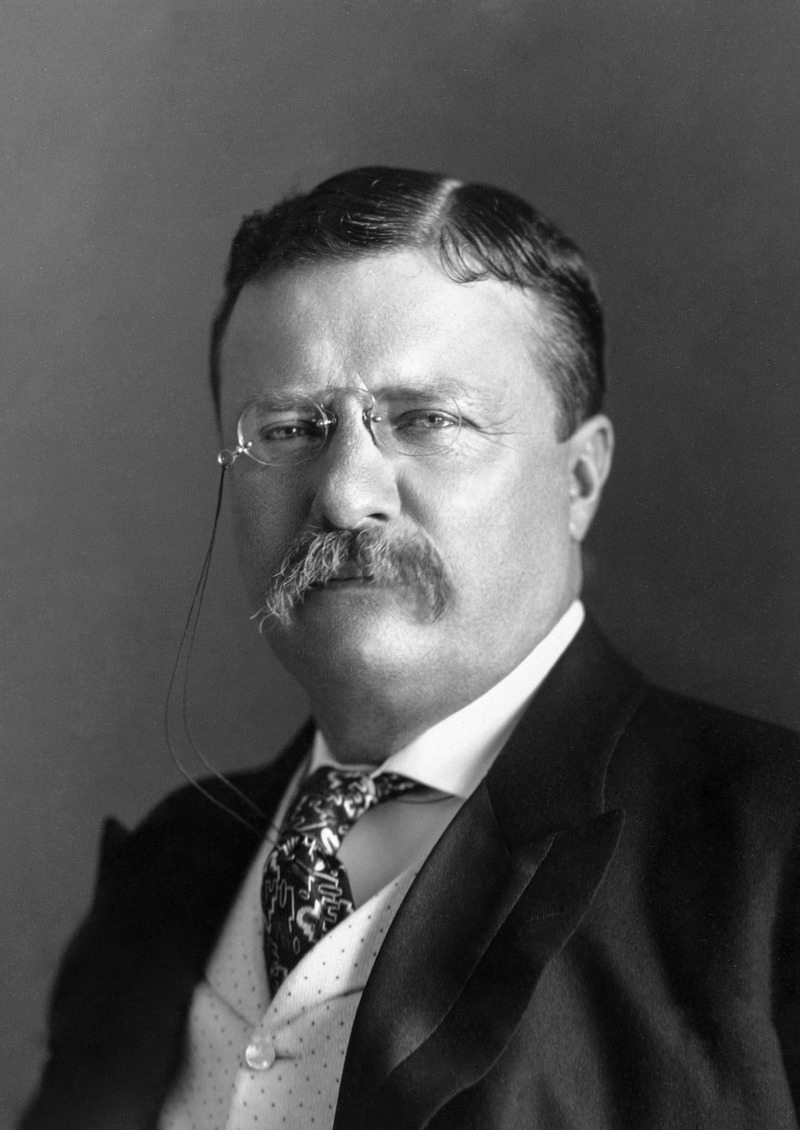
Public Domain
- In what ways did economies of the first half of the 20th Century reflect the principles of liberalism?
- How did progressivism signal a shift towards modern liberal values? Provide examples.
Curbing the Excesses of Economic Freedom
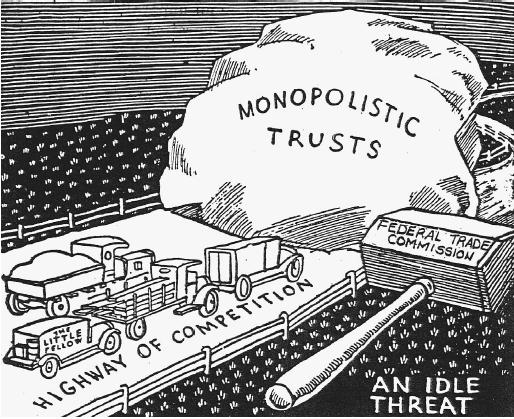
Public Domain
To ensure their control of the market, these large companies colluded with some of their competitors to eliminate any other competition. This led the U.S. government to pass the Sherman Anti-Trust Act in 1890. This meant that a conglomerate could not own two or more competing companies in one industry (like oil or steel manufacturing). This law was later strengthened in 1914 with the Clayton Act.
Learn more by going to the Khan Academy's The Progressive Era.
14. Quiz 3.2: Critical Viewing
Please go to the unit 3 tab and visit the 3.2 Quiz. Complete it.
15. Capitalism as Economic Liberalism
Overview: Capitalism as Economic Liberalism
Political and Economic Freedom

Economically, individuals also have many rights and freedoms under a liberal ideology, including the right to own property and make decisions about their money, including how to earn an income, where to invest, and what to buy and sell.
Laissez-faire capitalism is liberalism's answer to how an economic system should work. However, there are problems with an economy that has no regulations or controls.
In this section, you will develop a greater understanding of how capitalism changed in response to classical liberalism.
Friedrich Hayek's Austrian School of Economics (Supply Side Economics):
Milton Friedman's Monetarism (Supply Side Economics):
16. Laissez-Faire Capitalism
Laissez-Faire Capitalism
Every day, we make decisions about what we want, what we need, what we can afford, and how we can obtain goods and services. Within our capitalist economic system, most of those decisions are made by individuals who have the economic freedom to make choices.Historically, this was not always the case. In earlier times in many societies, the strong took what they wanted and the weak suffered. Hereditary rulers inherited power but also wealth and the authority to maintain their wealth. The rich got richer, and the poor struggled. Later, governments had much power over economic systems, preventing individuals and privately-owned companies from making their own decisions. In countries that adopted collectivist ideologies, there was little private property and limited economic freedom. Instead, these countries developed economic systems that valued collective interest and economic equality.
In some parts of the world, including many Aboriginal societies, there is no concept of private property. Land is not considered to be something a person can own.

What is an Economic System?
There are various economic systems, which are the ways a society makes decisions about how its
resources will be used. Some of these decisions include the following:
- Who will decide what goods will be produced?
- How will good and services be produced?
- How will goods and services be distributed?
- How will society deal with unlimited demands limited resources?

Laissez-Faire Capitalism
The first type of economic system based on classic liberalism was called laissez-faire capitalism.
Also known as economic liberalism, laissez-faire capitalsm belief in acting in one's own self-interest, competition, and the ownership of private property.
Economic systems based on these key principles are called free-market or private enterprise systems. Laissez-faire economists believe that natural laws control the economy and that no one, including the government, should regulate the economy because it works best when left alone.
The government does not have much role in the economy beyond providing rules to govern public safety. Review Adam Smith's ideas in the diagram.
Supply and Demand
In a competitive market, the price of goods is determined by the production balanced with the quantity demanded by consumers; the result is some kind of balance or equilibrium.
You don't need to know the specific economic characteristics, but how supply and demand helps establish prices and relies on individual self-interest and competition between producers for consumers.
The Business Cycle
There are natural ups and downs in production and economic activity over time. Periods of economic growth with general employment, high wages, and wealth creation are followed by periods of recession or depression in which the economy grows less quickly or even shrinks. Less is produced, unemployment occurs, and people have less money to spend.
History shows that the economy left alone to experience the business cycle booms and busts can severely impact the lives of citizens. This is covered in the next section.
Summary
Some Advantages
- Individual opportunities for wealth
- Freedom of choice in employment
- Wide selection of goods at low prices
- Rapid technological change and innovation
Some Disadvantages
- Income inequality
- Boom and bust
- Unemployment and/or under-employment
- Monopolies and cartels
17. Role of Government: Changes
The Changing Role of Government
Classical Liberalism and Limited Government
Classical liberal thinkers believed that the government's role should be restricted to security, stability and maintaining order. The government's only involvement in the economy was paying for a police force, courts and jails, and supporting a military to protect the nation from its enemies.
Evolution to Modern Liberal Economics
In almost every nation in the world, governments today play much greater roles in the lives of its citizens. Not only do they regulate industry to enforce safety and labour standards as well as protect the environment, they also provide essential
services that most people take for granted. The degree of involvement depends on how much support exists for collectivism. In some countries the government provides health care and education for everyone, builds and maintains the roads that everyone drives on, establishes and maintains water supplies and essential utilities such as electricity and natural gas, creates communication networks that connect people across the nation and around the world, and provides a minimum income for those who are unable to work. This ensures they are still able to keep other people employed by purchasing necessities such as food and shelter.
- To what extent should the government ensure services for its citizens?
- How did liberalism evolve from the idea that government should only protect rights to the larger role of guaranteeing greater equal treatment it has today?
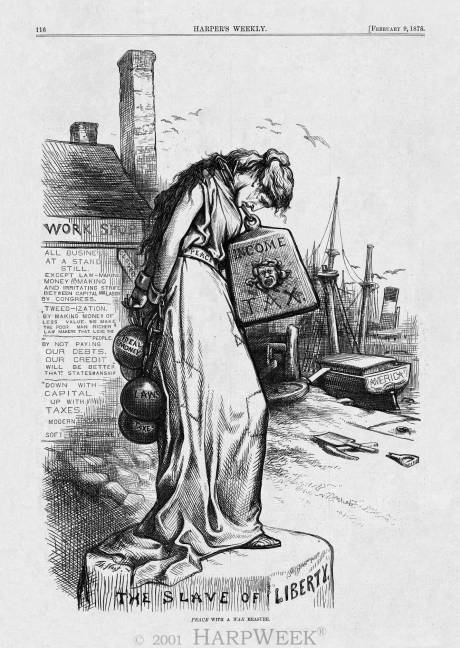
In it, the Statue of Liberty, symbolizing peace, stands with a heavy weight entitled "income tax" around her neck.
An old ship and a closed workshop represent the fact that a long economic depression was just ending while the vultures overhead indicate death is near.
Liberal Context of the Image
The first income tax in the United States was established in 1861 to help pay the costs of the U.S. Civil War. It amounted to 3% of a person's annual income for anyone who earned more than $800 per year. While that doesn't seem like much to us today, back in the 1800s the average worker made less than that amount and so he did not have to pay any taxes.The tax was in effect for less than ten years, and then it was abolished. When businesses and politicians proposed replacing their business taxes with income tax, many Americans were outraged. The proposed income tax bill was defeated, but the next income tax bill passed.
- What do you think the cartoonist thinks about income tax during peace time?Does the ideological perspective reflect classical liberalism or modern liberalism? How do you know?
- In other words, what links can be made between the source and liberalism can be made?
SEE THE EXEMPLAR HERE.
Benjamin Franklin
The Purpose of Income Tax
Today, we take the idea of income taxes and consumption taxes for granted, but it has not always been the case. For many years, countries with classical liberal economies obtained their incomes from tariffs and other business related fees. However, when they needed money, they began to consider a new form of revenue-income tax.The first income tax in Britain was introduced in 1798 to pay for the costs of the Napoleonic Wars. In Canada, income tax was introduced in 1917 in order to finance Canada's expenses in World War I. It amounted to 4% on all income of single men over $2,000. Canadians with annual incomes of more than $6,000 paid an income tax of 2 to 25 per cent.
As the decades passed, income tax became a necessary way for governments to fund services. During the 20th Century, as government played a greater role in the lives of its citizens, so did the the type and complexity of taxation. This will be explored in greater detail in Unit 6.
18. Economic Liberalism
Economic Liberalism 1900-1929
You learned about the first years of the 20th Century, and various attempts to provide better working conditions through Welfare Capitalism, and political movements such as progressivism. During the first World War (1914-1918) there was an unprecedented "total war" in Europe with the participation of almost every nation in the world. During this war, national governments supported their military involvement through building up their armies and providing the "material" necessary for war. The war forced governments to go into greater debt.
While the Soviet Union battled itself with a civil war, the rest of the developed world continued with economic liberalism. The decade after the first World War became known as the "Roaring Twenties." Soldiers re-entered the workforce. Their wartime wages and hope for the future fueled the economy. Europe was in a rebuilding phase, and governments borrowed to restore their countries. There were many technological innovations that spurred consumerism such as automobiles, movies and radio. Not only did many new consumer goods hit the market, but businesses began to sell products on credit. Customers could pay in installments and pay of their new product month by month.
Western Europe was rebuilding their war torn land and economies. American farm production was booming due to European demand for bread. Increased consumer demand from Europe and overall confidence about the future in Europe and North America led to great industrial growth.
- How did the prosperity of the 1920s reflect classical liberal principles?
19. The Great Depression
The Great Depression 1929-1939
Economists characterize a depression as a period when around 25% or more of the working population is out of work, which lasts for more than 6 months. The Great Depression lasted 10 years.
The Stock Market Crash in 1929
During the 1920s many people borrowed credit or money to invest in the stock market. In many cases, people could buy stock 'on margin' which was essentially borrowing money in the hopes that the profits made in the market could repay the borrower.In October of 1929 stock prices started to fall. This led to more and more people selling off their stock for cash. As this happened, stock prices began to fall, and this led to further panic and a drop in stock prices. Banks began to call in their debts, requesting that investors pay back their initial loans, but in many cases, there was no way to pay off the banks if the stocks they held were worth much less than the original price.
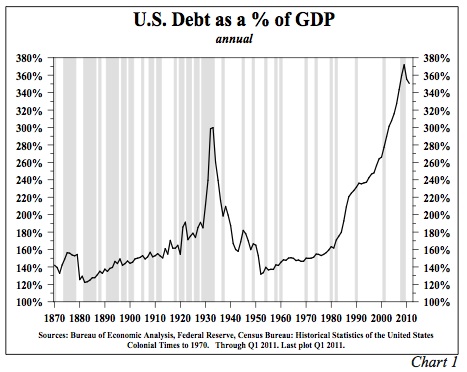
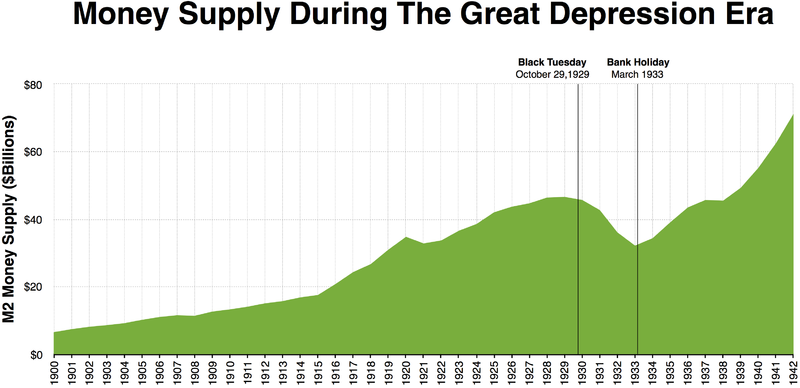
Why the 'Great' Depression?

Courtesy Wikipedia
Early Political Responses to the Depression
By 1933 this still had not happened, and the lack of government services to improve their plight led the American people to vote in a new President with hopes for a solution.
Learn more about the iconic photograph by Dorothea Lange, 'The Migrant Mother'.

Courtesy U.S. Library of Congress
FDR & The New Deal
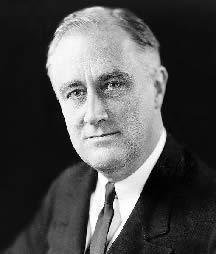
His ideas about government intervention in the economy were influenced by the ideas of John Maynard Keynes, a British economist. You will read more about Keynes (pronounced "canes").
The Three Rs
Roosevelt proposed that the government should sponsor a series of programs that would provide:
- relief to the unemployed
- reform to the economy
- recovery from the Depression
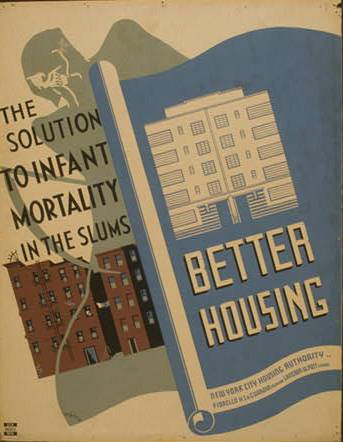
Roosevelt's first set of programmes included immediate short term relief for people who could not get work. He set up new legislation for banks, and called a bank holiday as seen in the Money Supply Chart above. This limited the amount of money customers could withdraw and helped re-stabilize the banks. Many banks immediately reopened, allowing cash to flow back into the system.
- He took the country off the gold standard and allowed the US dollar to float on the foreign exchange market. He cut the salaries of government employees and veterans' pensions by 15% which saved the government millions of dollars.
- Using the laws of supply and demand, Roosevelt raised prices for farm products by reducing the supply with the idea that the less that was produced, the higher the price and the higher the income to the farmer. In some cases, crops were plowed under or allowed to rot. Baby pigs were slaughtered. Farmers were paid not to grow crops. Food production was taxed.
- To deal with the widespread poverty in the South, people were hired to provide programmers to benefit society. Schools and roads were built, school lunches were provided, national forests were enlarged and people were hired to plant trees and to build dams to prevent flooding and generate electricity to modernize poor areas.
- Another popular move in his first hundred days was to get rid of the law that prevented the manufacture and sale of alcohol, called Prohibition, which had been in effect since 1919.
- A major program for public works saw $3.3 billion in taxpayers money go to private companies to build 34,599 projects.
- Industrial leaders were brought together to design codes for each industry, leading to a 45% increase in production.
The most important program of 1935, and possibly the New Deal itself, was the establishment of a social security network funded through payroll deduction. This program, the framework for today's welfare system in the U.S. included universal retirement pensions, unemployment insurance, and welfare benefits for poor families and the handicapped.
- An increased role for government in the economy, especially in times of economic crisis
- Social Security to protect the weakest members of society
- Regulations giving labour unions more power
- Organization of agriculture , including the regulation of agricultural production and the provision of subsidies to farmers
- Public works projects. For example, the huge Hoover Dam outside Los Vegas.
To view, select this link. It is not required viewing, but it does present an interesting ideological perspective.
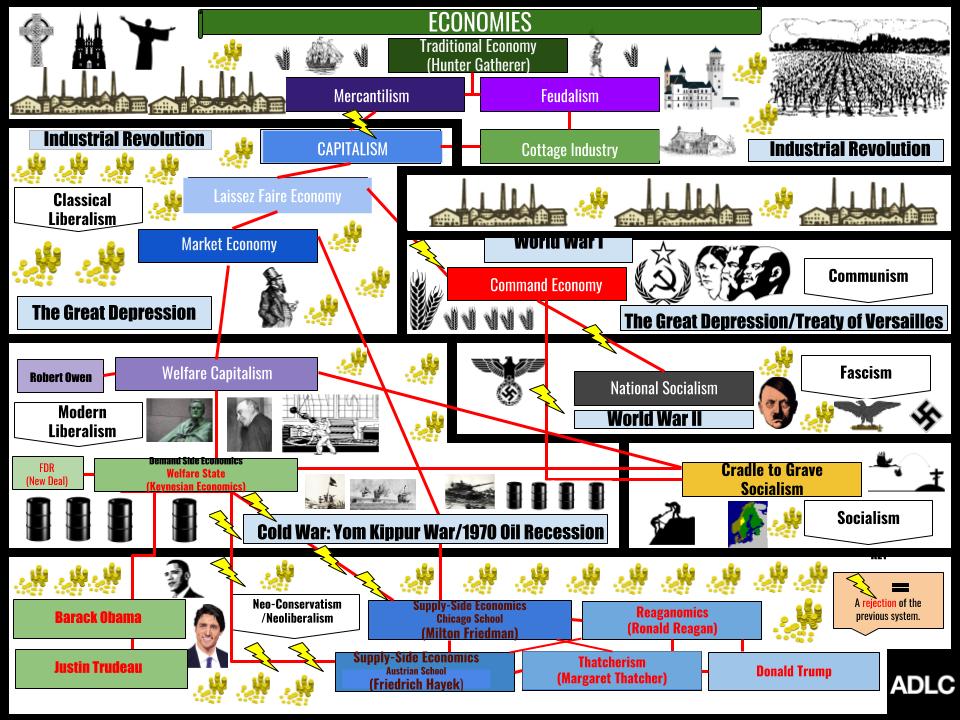
- View a slide show to learn more about the legacies of the New Deal.
Download and print the "Great Thinkers 2 Trading Cards" to take notes on FDR's
revolutionary government intervention and shift to modern liberal economics.
20. The Great Depression in Canada
Economic Success to Economic Disaster

Inscription: ANOTHER CASE OF ATTEMPTED DESERTION AND ABANDONMENT OF FILIAL RESPONSIBILITY
Click on image to enlarge.
Unlike the US government, the Canadian government did not take immediate and extreme action to deal with these issues. When the Depression began, Liberal Prime Minister MacKenzie King was in power. He believed the economy would right itself. He lost the 1930 federal election to Conservative R.B. Bennett who made some minor attempts at creating work projects for the unemployed, but he maintained a laissez-faire attitude.
Consider the political cartoon to the left. The cartoonist shows the Liberal Party, as symbolized by the man on the left wearing a working man's cap representing former Liberal Prime Minister Mackenzie King putting on the Conservative government's doorstep a baby, in a basket entitled "Getting rid of the Liberal government's administrative errors".
Bennett's policies led to the formation of the Bank of Canada, the central bank of the country. Prior to Bennett's rule, banks in Canada were privately owned. The Bank of Canada was used to regulate the economy. Today, Canada's banking system is considered by the World Economic forum to be the most efficient and safest banking system in the world.
Eventually, Bennett tried to implement similar policies to those of the New Deal, but many were struck down by the courts. In 1935, he lost the federal election to MacKenzie King, who implemented many of the social programs that remain in effect in Canada today.
Bennett was a wealthy man who had grown up in a relatively poor household. He lived by the motto "Work as hard as you can, earn all you can, save all you can, and then give all you can." However, he often flaunted his wealth, which made him unpopular with the thousands of unemployed Canadians. During this period in history, many Canadians owned cars but could not afford gas. Often, they removed the engine and windows and pulled the car with horses. These vehicles were named "Bennett buggies" as a discredit to Prime Minister Bennett who many blamed for the country's poverty.
- What ideas are presented about classical liberalism and laissez-faire capitalism?
- How did these signify a shift from classical to modern liberalism?
21. Keynesian Economics
Keynesian Economic Theory
As the Great Depression showed, the free-market economy does not always correct itself immediately during cycles of boom and bust. In fact, the Great Depression seemed to get worse as time passed, causing hardship
for many.
The "natural law" according to classical liberalism is that where there is economic freedom the economy will correct itself. Classical liberal economic theory follows a belief that if producers are given the economic freedom to produce goods and
services, they will produce what people want and the invisible hand economy will meet the most needs of individuals. Although classical liberals agreed that bad times will be followed by good times, and the instability of the free market system,
they also believed that through self-interest of entrepreneurs and investment, the market would fix itself.
Classical liberal economists also believe that self-reliance and self-interest will lead people to save their earnings for recessions
or depressions. The assumption was that people and governments supposedly understand this cycle, and therefore they will save when times are good (boom) to protect themselves when times are bad (bust). Therefore, there is no need for the government
to get involved.
Think about this for a moment. Is this assumption of human nature and self-interest true for people you know? Do individuals save when times are good? Do they know or anticipate when the economy is about to take a downturn?
Does the market always regulate itself?
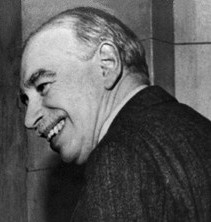
British economist John Maynard Keynes did not believe that the economy would always correct itself according to the principles of classical liberalism.
During the depression, he saw that the business cycle was not stable. He felt that during times of economic instability, people tended to hang on to their money. He saw that when times were bad, people were not confident in the economy and did not invest. This caused further downturn and prolonged the recession.
Keynes' Demand Side Economic Theory
Keynes believed that consumer demand causes the highs and lows of the business cycle. When times are good, people spend freely, causing inflation.It also leads to an oversupply of goods that no one wants to buy. When times are bad, people do not spend or invest, creating a downward spiral. Effective demand means that supply and demand works only when consumers have purchasing power. Keynes ideas were called demand-side economics, as opposed to supply-side economics.
Keynes believed the government should regulate and stimulate the economy. When the business cycle is on an upswing, the government and its central bank should raise interest rates and raise taxes to encourage people to limit spending and save their money while at the same time reducing government spending. This would cool economic activity. As the economy slows, the government should lower interest rates, lower taxes, and increase government spending even if it means the government has to go into a temporary deficit that would be paid back during boom times.
Decreased taxes and lower rates for borrowing would put more money in people's pockets, leading to increased spending that would pump money back into the economy.
Keynes' Solution: Fiscal and Monetary Policies
Keynes' theories included both fiscal and monetary policies. Fiscal policies include government spending, taxation, and government borrowing. Monetary policies are those that control the money supply in a country, including printing money and establishing interest rates.
Classical Economic Theory |
Keynesian Theory
|
|
|
|
|
|
|
Keynes ideas were implemented in many countries during and after the Great Depression. Keynes was one of the chief economic advisors at the Bretton Woods Conference, which was an international conference held near the end of World War II to help prevent another global recession. The Bretton Woods Conference helped establish international rules for trade, the World Bank, and the International Monetary Fund, large institutions that all had a part in preventing another Great Depression following World War II.
His ideas remained a powerful influence until the early 1970s, and there is renewed interest in them today. There will be further examination of various modern economic systems in Unit Six.
As you read, consider the issue question:
- How did Keynesian demand side economics alter classical liberal approaches to the business cycle?
- What ideas are presented about classical liberalism and laissez-faire capitalism?
- How were these ideas a rejection of classical liberalism or an extension of greater freedoms for all?
- How were these policies and programs justified?
Keynesian Economics and Today's Economy

- Who is represented by the character in the hat?
- What is the cartoonist's perspective on Keynesian economics today?
- What perspective does he have regarding classical liberalism?
The Recession of 2008
The modern industrial world entered a recession in December 2007. It was precipitated by the deregulation of the banking industry and speculation in American real estate and equities. Financial institutions loaned money recklessly to unsecured borrowers for mortgages; the result is sometimes referred to as the "subprime lending crisis".For example, lenders Fannie Mae and Freddie Mac were allowed to buy people's mortgages without keeping any significant amount of capital on hand. In other words, these financial institutions owned other people's debts. As house prices increased, and people were forced to renew mortgages at rates they could not afford to repay, they defaulted on their loans. These companies were left owning the titles to properties that no longer had significant value.
For example, a house with a mortgage of $300 000 now might be worth less than $100 000. In other words, banks loaned money to people who had no form of security and had not shown that they had the ability to repay their loans. Many people bought houses at inflated prices, renegotiated their mortgages, and ended owing more than they could hope to repay.
As the crisis mounted, many large banks and lending organizations faced failure and bankruptcy. International trade decreased. Thousands lost their jobs.
The global recession led many governments, especially that of the United States, to look at Keynesian policies again. The American government spent millions bailing out industries that failed or were about to fail. Classical liberal economists (free-market supporters) largely criticized this move, as they believed this intervention distorted the natural course of the business cycle, giving these companies an economic advantage. Modern liberals applauded the intervention, claiming that the mass unemployment would have caused undue suffering across America. In essence, the decision was these companies were simply 'too big to fail'.
22. Quiz 3.3: Economic Systems
Please visit the unit 3 tab and click on Quiz 3.3. Complete it.23. Modern Liberalism
Understanding Modern Liberalism
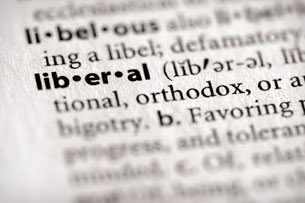
There was a great deal of resistance to liberal practices by those who benefited from the status quo or existing way of doing things. The nobility did not want to give up their power to the working
class. The rich did not want to extend economic freedoms to the poor. Many men did not want to give women equal rights.
Those with ethnocentric beliefs did not want to give equality to people from other backgrounds. Modern liberalism came into being through the efforts of many people who fought, not always peacefully, for the rights and freedoms that people in liberal democracies experience today.
Some examples include the following:
- The women's suffrage movement led to voting rights for women.
- Human rights activists successfully lobbied for an end to slavery and equal rights for all.
- Gradual change at the government level led to the extension of universal suffrage in most liberal democracies.
- The labour movement protested against unsafe working conditions and unfair wages, leading to legislated labour standards.
- Former colonies were granted their independence after World War II under the principle of self determination.
- Protests by citizens to expand equal treatment under the law for various minority groups (Example: LGBTQ)
Positive and Negative Liberty
The social, economic, and political changes that resulted from their efforts led to a new kind of liberalism that includes both negative and positive freedoms. Both classical liberalism and modern liberalism are
based on the idea of freedom. But does liberalism mean freedom "from" something, or is it freedom "to do or have" something?
Classical liberals tend to think of individual liberty as freedom from external obstacles or constraints. That is, people are free to act if others do not interfere. According to Thomas Hobbes, "A free man is he that, in those things which by his strength and wit he is able to do, is not hindered to do what he hath the will to do."
Modern liberals have a broader conception of individual liberty. Modern liberalism holds that freedom means more than simply being told what you can or cannot do. For people to be truly free, they must have the capacity to realize their own goals and dreams. Modern liberals think of liberty as freedom to achieve personal goals and self-fulfillment. For example, a child born into poverty, with little opportunity to escape his or her situation, is not really free to develop to the full extent of his or her abilities. To overcome these obstacles, a certain measure of equality must be ensured.
The Cycle of Negative and Positive Freedoms
The principles of liberalism dictate that people should not only be free from outside forces telling them what to do and how to live, but also that they should be free to have equal opportunities. Balancing negative and positive freedoms for the common good is a challenge in any liberal democracy.Positive freedoms may interfere with negative freedoms. They often lead to greater government involvement in our lives. Some people see government actions as interference with their rights. If the government establishes safety regulations that say you cannot smoke in a public place so that people will be free from second hand smoke, smokers have some of their freedoms taken away. If we give every child the right to an education, or every person the right to free health care, then it must be provided through taxation. When every child is guaranteed the right to a public education through public schools, and every person is guaranteed the right to healthcare, corporations lose the ability to compete for the "business" of providing schools and hospitals.
Liberalism and Notion of Equality
Liberalism, as most people understand it today, includes not only all the principles of classical liberalism but also the belief that all people should be free to make their own choices, pursue their own dreams, and take responsibility for the results.
In other words, modern liberalism includes the belief in the inherent equality of human beings.
However, we know historical, racial, personal, economic, and gender-based inequalities exist today. In a democratic society, modern liberalism includes a greater role for government in ensuring people have greater opportunities. Just how great a role governments should have remains an area of debate.
- What are the differences between classical and modern liberalism?
- How might a change of emphasis from equality of opportunity to equality of outcome affect society?
- To what extent should governments address the demand for equal outcome?
24. Labour Movement
3.3.4 The Labour Movement
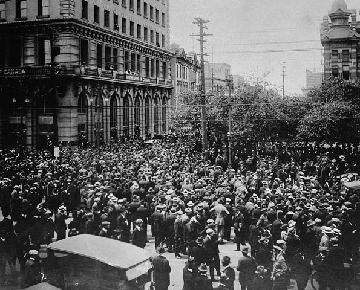
Montreal Star, June 21, 1919.
Courtesy Library and Archives Canada PA-163001
The picture is of the Winnipeg General Strike of 1919, an influential strike of workers in Canada.
Although many Canadians had prospered during World War I, when soldiers returned from the war, many found that immigrants had taken their jobs. For those who found employment, working conditions were often poor. Few laws protected worker safety. Few of the benefits most workers have today were available. Wages for average labourers were low. The average worker had very little opportunity to voice his or her concerns about issues in the workplace. The communist revolution had just occurred in Russia in which the workers, soldiers, and farmers had taken power from the aristocracy.
In Winnipeg, workers in the building trades negotiated for better wages and working conditions. When talks broke down, the Winnipeg Trades and Labour Council called a general strike. In hours, nearly 30 000 workers walked off their jobs, closing factories, stores, and the rail lines. Government workers followed, including the police. Firefighters, postal workers, telephone operators, and utility workers joined the private sector employees, virtually shutting down business activity in the city.
Reaction was swift. The strikers were condemned as revolutionaries led by foreign Bolsheviks. The federal government and sided with the business community. Organizers were arrested, and the RCMP rode into a crowd of protesters, a confrontation resulting in many injuries and one death. The strikers went back to work, but a bitter legacy remained. It took another 30 years before the rights of workers were recognized.
Read "Labour Standards and Unions" on pages 154 to 156 of your text, Perspectives on Ideology.
- How does the labour movement reflect modern liberalism?
- How does the labour movement reflect collectivist principles?
25. Universal Suffrage
Universal Suffrage
When we think about the right to vote (suffrage), we frequently think about the rights of women. But women were not the only people unable to vote after governments adopted classical liberal principles. Working class men, the foreign born, and people
without wealth or property could not vote in many countries. The evolution towards modern liberalism meant gradual enfranchisement (voting rights) for all citizens. In the United States, African-American slaves in the South could not vote until slavery was abolished. In many parts of the South, black voters were disenfranchised (denied their right to vote through voter registration control) until the Civil Rights Act of 1960 protected their right to vote. In Canada, First Nations people could not vote until 1960. In fact, almost half the adult population in most liberal democracies was not allowed to vote until sometime in the 20th century.
Today, the mentally ill, the mentally handicapped, and people in jail cannot vote in many nations. Women in some countries still cannot vote.
Without the universal right to vote, are people really free? If citizens cannot choose their elected officials, who determines "rule of law" or decides what individual rights and freedoms, including economic freedom, to which the average person is entitled? The development of participatory democracy in which all adult citizens are entitled to make choices about their government had a key role in the evolution of liberalism.
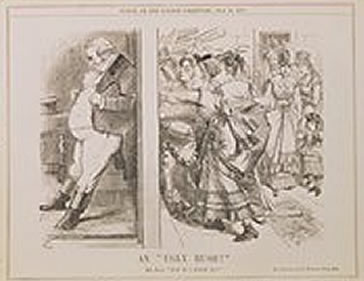
Symbolism
John Bull personifies Great Britain in political cartoons. He is usually depicted as a stout, middle-aged man, often wearing the Union Jack on his vest waistcoat.
Exaggeration: John Bull is large and well-dressed; he has his eyes closed, showing how rich and disconnected with reality he is. He is ignoring the women activists.
The women banging on the door are old and unattractive, but those with their heads bowed in the background are young and beautiful and have children. This shows the stereotype that political activists are ugly and old and that beautiful young women are embarrassed by their politically active counterparts.
Labelling
AN "UGLY RUSH". Does the word "ugly" mean that the women's rights activists are ugly, or that it is somehow "ugly" or inappropriate for women to demand equal rights?Mr. Bull. 'Not if I know it!' John Bull, representing Great Britain, implies that women will never get the vote as long as he continues to ignore them although it is taking a lot of his energy to do so.
The signs "Woman's Rights" and "Electoral Qualifications" show the issue being debated.
Read "Universal Suffrage" on page 157 of your text, Perspectives on Ideology.
- How did universal suffrage reflect modern liberalism?
26. Women's Rights
3.3.6 Feminism & Women's Rights
Feminism is the ideology that believes in women being equal to men. This ideology grew into a political movement throughout the 20th Century. The caption of the poster is as follows:
Women's Club. We ask
- That the underskirt is replaced by trousers.
- That the husbands are home at least three times per week.
- Finally there shall be between the man and the woman no other distinction that that with which nature granted them.
Watch the following video to better understand how greater equality for women meant greater equality for all people in society.
Greater Equality for Women
Most people in liberal democracies today would say that all women should be equal to men. Some might say "equal but different", but most people believe that everyone is equal under the law and should be subject to the same laws and opportunities. However,
this has not been the case throughout history. It took centuries after the Enlightenment for women to obtain the right to be treated equally, including the right to vote. Women in many countries of the world today still do not have rights equal to men. From the perspective of some religions, women do not deserve equal rights, or they need a degree of protection that, in fact, limits their rights to the kind of full participation in society that women in Canada experience.
Think about the language used in many historic documents, including some of the key documents in the history of liberalism. Today, we sometimes think about the word "man" as a synonym for mankind, or all humanity, but in the days in which those historic documents were written, men did, in fact, have fundamental rights that were denied to women.
- The 1793 French Declaration of the Rights of Man refers to the natural, unalienable, and sacred rights of man.
- The 1776 US Declaration of Independence states, "... all men are created equal, that they are endowed by their Creator with certain unalienable rights."
- A British ruling in 1876 stated, "Women are persons in matters of pains and penalties, but are not persons in matters of rights and privileges."
Historical Canadian Example: The Persons Case in 1928
In the 1920s, five Alberta women, Emily Murphy, Irene Parlby, Henrietta Muir Edwards, Nellie McClung, and Louise McKinney, fought to have women recognized as persons under the law. Although Emily Murphy had been appointed a magistrate, she was not
considered to be a "person" under the law. Nor was any woman. The landmark decision to recognize women as "persons" was a milestone on the road to full rights for women in Canada. These women were some of the first feminists in Canada.
- Explain how feminism, and the desire for greater equality, was a reaction to classical liberalism in many Western societies.
- Can you think of contemporary issues that challenge equality rights today?
- How do non-liberal societies view universal suffrage and feminism?
27. Welfare State
The Welfare State

Your readings about the New Deal and Keynesian economic theory showed that as liberalism evolved, a greater role for the government in the lives of citizens developed. Today this is known as a mixed economy.
As more citizens obtained voting rights, voters chose representatives who saw that government could do more than enforce the rule of law and provide national defense. The government could also provide programs and services that would benefit all people.
A country that is capitalist but uses policies that intervene in the market to ensure stability and a basic standard of living for citizens is called a welfare state. There are many kinds of welfare states in the world: some "cradle-to-the-grave" welfare societies have governments that take responsibility for the well-being of all citizens, and others provide social safety nets, or a limited number of programs and services, sometimes temporarily, to help those who are unable to help themselves.
The programs provided in a welfare state are usually funded through tax dollars. Although all taxpayers receive benefits of social programs, higher income earners tend to pay more in taxes while lower income earners benefit more. This transfer of money reduces overall poverty in a country.
These welfare services can include any or all of the following:
- federally-funded pensions
- programs to benefit those who traditionally have been discriminated against
- universal health care
- free public education for all
- income assistance for the unemployed
- universal daycare programs
- incomes for the severely handicapped or those unable to work
- maternity and/or paternity benefits
- Why would modern liberals support the welfare state?
- How would classical liberals respond to the welfare state?
- What is the difference between a welfare state in a mixed economy and one in a democratic socialist state?
28. Human Rights
The Fight for Human Rights
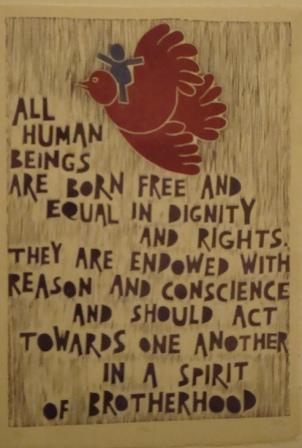
Human rights are key to liberalism, yet under classical liberalism, these rights were not fully experienced by all people. What are "human rights"? They are the basic rights to which all people are entitled. What exactly does that mean?
Human rights, or the idea that all people are entitled to justice, is sometimes called "natural law"-the idea that rules set out by nature apply to everyone worldwide. However, are these "laws" really natural? Humans have suffered from injustice throughout their existence, and the human rights of individuals and groups continue to be violated around the world today.
The concept of human rights is not limited to western liberal democracies.
The ancient Greeks believed in human rights. The Enlightenment philosophers discussed the idea of a social contract or unwritten agreement between the rulers and the ruled. Many religions have promoted universal human dignity. The South African concept
of ubuntu is the idea that by being human we are connected automatically to other people, and through this connection, we all recognize that our actions affect each other.
We think of ourselves far too frequently as just individuals, separated from one another, whereas you are connected and what you do affects the whole world. When you do well, it spreads out; it is for the whole of humanity.
Archbishop Desmond Tutu of South Africa
In this unit, you have looked at equal rights for women and working people. Those rights include the right to vote, the right to equal treatment under the law, the right to work, the right to be safe at work, the right to negotiate for fair wages, etc.
Most liberal democracies identify the rights of their citizens in their national constitutions. In Canada, this is the Charter of Rights and Freedoms.
International human rights were laid out in detail by the Universal Declaration of Human Rights by the United Nations in 1948 and signed by almost every nation in the world. Although the declaration is not a binding agreement, it does record many of the individual rights and freedoms that people aspire to around the world today.
The development of a well-articulated list of rights was an important step on the path to modern liberalism.
The History of Human Rights:
The History and Importance of the Magna Carta:
29. Unit three Summary
Unit Three explores the evolution or gradual change of classical liberalism into modern liberalism.
During this time of great political, economic, and social change, the freedoms that were obtained by the upper and middle classes under classical liberalism were extended to all adults. When the self-interest and economic freedom of classical
liberalism were coupled with democratic demands for greater protection for the average person, a new ideology resulted.
| What historical events shaped modern liberalism? | What new ideologies resulted from the challenges of classical liberalism? | What people influenced modern liberalism? | What social structures changed? |
|
|
|
|
In the next unit, you will investigate resistance to liberalism in the forms of communism and fascism and other conflicts.
Although classical liberalism brought many positive changes, it also presented challenges that resulted in changes to liberalism. With the extension of voting rights and human rights for all, a greater role for government, and a greater focus on collective interest, the ideological perspective of many ran counter to liberal principles.
Many did not agree that modern liberalism in any form would ever be the best ideology, no matter how many changes were made. They called for total rejection of liberalism and the implementation of new political and economic systems.
In the following unit, you will study communism, fascism, and other conflicts in the twentieth century as you explore the following issue question:
- To what extent is resistance to liberalism justified?
When you have finished reviewing your notes, complete the Unit Review for Unit Three. When you have completed the multiple choice review, take a look at the feedback provided. If you so choose, after waiting 30 minutes, you may complete the quiz again, keeping in mind that the questions and the order of the possible answers are randomly generated. The second version of the review will be different from the first.


